Introduction to local social media marketing
In this course, we’re going to distill social media marketing down to the essentials so you can have a clear plan of action for growing your local business. We’re going to cover:
- The basics and benefits of social media marketing
- How to get started with your plan and profiles
- Local social media ideas, tips, and best practices
- Local marketing strategies and examples for each platform
But first, let’s get acquainted with the world of social media.
What is social media marketing?
To say that social media has evolved is an understatement. It went from a simple way for friends to connect, to a huge part of daily life for both people and businesses. Social media is now used by 4.48 billion people (nearly 60% of the world’s population) to find virtually anything they need—information, recommendations, games, jobs, lost pets, and lucky for you, local businesses.
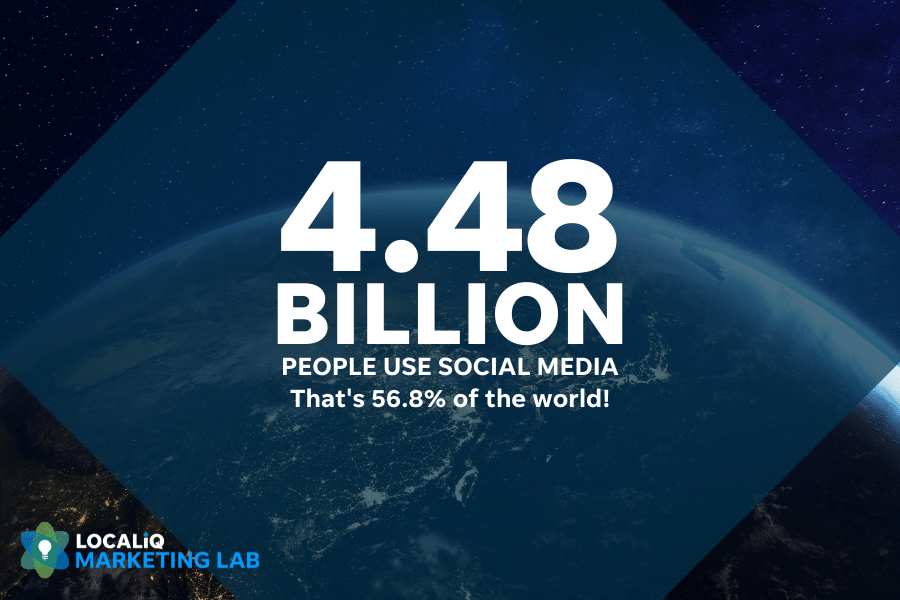
But perhaps unlucky for you, there are now too many platforms to count, each one ever-expanding with its own set of features, post types, and best practices. Keeping up with your business is hard enough, let alone multiple platforms that can’t even seem to keep up with themselves!
So if you’re having trouble knowing where to start with social media marketing—or even to just wrap your mind around it—you’ve come to the right place, my friend. Because that’s what this easy-to-understand social media marketing course is all about!
Social media marketing defined
Social media marketing refers to the use of social media platforms to grow your business (shocking, right?). With half the world using it for an average of 2.4 hours a day, it’s no wonder social media is a staple marketing strategy for any business today—including small and local businesses.
Let’s take a look at some social media stats.
- 96% of small businesses use social media in their marketing strategy.
- 41% of local businesses depend on social media to drive revenue.
- 80% of consumers use social media to engage with brands.
- 74% of consumers rely on social media to guide purchasing decisions.
As you can now see, social media marketing isn’t just helpful for businesses because it’s popular among consumers; it’s also popular for businesses because it helps consumers!

All of this boils down to two things. One, you’re doing your local business a disservice if you’re not using social media for marketing. And two, with so many businesses on social media already, you’ve got to find ways to stand apart from competitors and stand out to your customers.
You’re going to learn how to do that with this course, so let’s get started by understanding the most popular social media platforms used for marketing.
What are the best social media marketing platforms for local businesses?
Some social media platforms are better suited for particular marketing goals and business types than others. Knowing which to use for what purpose can make a big difference in your social media marketing success. We’ll be going into more specifics for each platform later in the course, but for now, let’s just get familiar with the basics. We’re going to cover:
- TikTok
- Snapchat
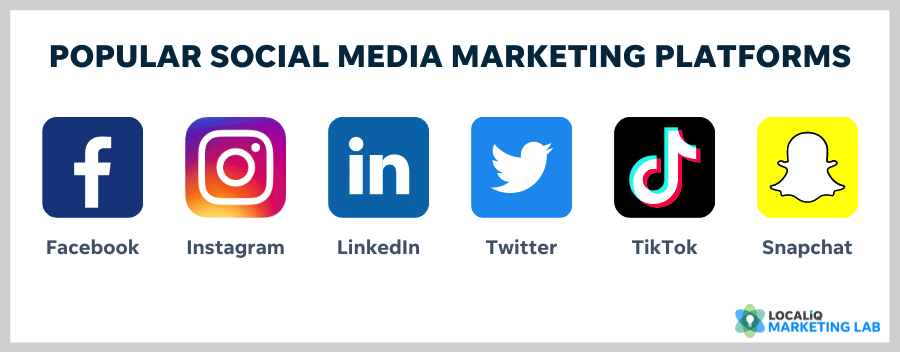
Facebook was launched in 2004 and has the biggest user base of all the social media platforms, with 2.85 billion monthly active users worldwide. That’s 8.5 times the population of the US! It also has the most even age distribution compared to other platforms.
Facebook is a great channel to: Build relationships, keep customers updated, and connect with your local niche.
Instagram was launched in 2010—eight years after LinkedIn and four years after Twitter—but has already surpassed both platforms with over one billion monthly active users. Not only do its multiple posting formats make it a versatile platform for marketing, but also, it is used by 81% of consumers to research products and services.
Instagram is a great channel to: Build your brand aesthetic, reach people with relevant interests, and promote your products.
LinkedIn, launched in 2002, has 310 million monthly active users and is the most popular for B2B social media marketing. But that is far from its only purpose. While there’s a heavy focus on business, there are many great themes on this platform that make it a valuable local marketing tool.
LinkedIn is a great channel to: Help others grow, share industry insights, and express thought leadership.
Twitter is a massive network of individuals and brands (353 million active monthly users, to be exact) interacting with each other through quick messages (320 characters or less, to be exact). Its real-time nature is unmatched by any other social media platform, making it a good place for timely discussions (and lots more).
Twitter is a great channel to: Connect with your virtual niche, share relevant news, and broaden your perspectives.
TikTok
TikTok began in 2016 and yet already has 100 million monthly active users. In that time of rapid growth, it’s become one of the most downloaded apps and is used by nearly every demographic, making it a natural fit for businesses looking to connect with an engaged audience.
TikTok is a great channel to: Express your brand personality, keep up with trends, and make memorable impressions.
Snapchat
Snapchat is commonly disregarded by marketers as a platform for teenagers, but the largest age group on the platform (75%) actually ranges from 13-34. And with tools like Snap Maps and its partnership with Gannett, it’s more locally-focused than you might think.
Snapchat is a great channel to: Reach nearby audiences, show your creativity, and demonstrate transparency.
There are other social media platforms, like Nextdoor, Pinterest, WhatsApp, and Reddit, but the most popular ones listed above are what we’ll be discussing in this course. And as mentioned above, we’ll provide ideas on what and how often to post on each channel later on.
What are the benefits of social media marketing for local businesses?
1. Social media marketing helps you connect with your audience anytime, anywhere
Social media is mobile-friendly (if not mobile-based), so as long as you have a smartphone, you can market your business no matter where you are and reach your audience no matter where they are.
Waiting to be seen by the dentist? Post a promotion or check in on a contest you’re running. Serendipitously met a prospective customer on the train? Pull up your Instagram album to show them examples of your work. Mobile marketing doesn’t get any easier than that!
2. Social media marketing is affordable
Not only is social media one of the most effective marketing channels, but it’s also one of—perhaps THE—most affordable strategies out there.
- It’s absolutely free to create accounts for each platform.
- There are endless free tools for creating content, scheduling posts, shortening links, and reporting on your content.
- Social media management platforms range from free to about $30-50/month.
- Paid ads on social media typically have a lower cost per click than on search engines.
- It’s one of the top three marketing channels that yield the highest ROI.
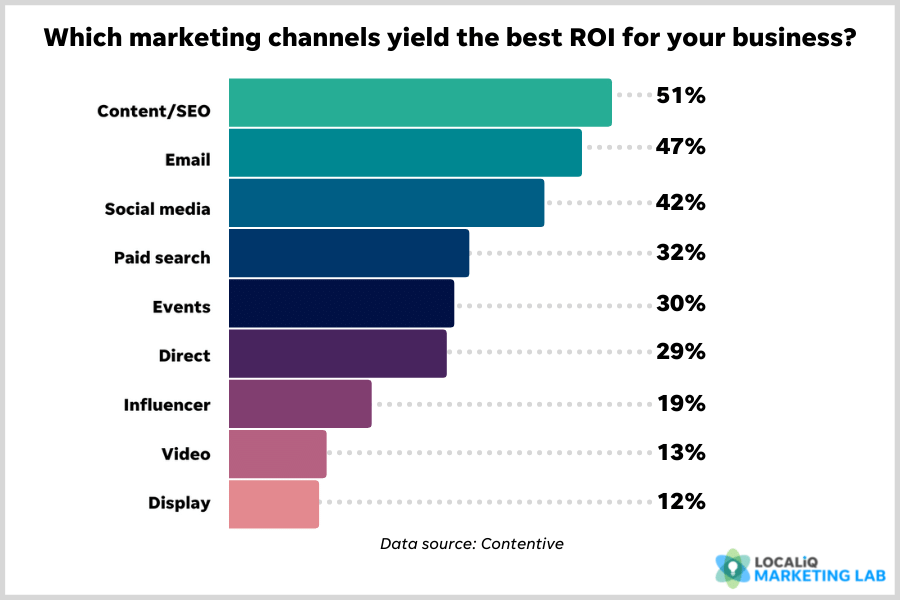
3. Social media marketing humanizes your business
Social media doesn’t just develop the aesthetic of your brand; it personifies your business, setting the stage for an emotional connection with your audience.
Your activity on social media and the historical feed you build forms a complete persona of your business—how you converse, what you look like, causes you support, opinions you express, values you stand for, interests you have, and products and services you offer.
In other words, it doesn’t just build your brand—it brings it to life and gives people something tangible to connect to, engage with, and remember.

4. Social media marketing amplifies your reach
This is the beauty of the “social” in social media marketing. Customers, fans, and followers will market your business for you! They might:
- Share links to your content on their feeds.
- Repost your posts.
- Post about your business and tag it.
Now, your business isn’t just appearing in your network, but in the networks of your followers. Pretty neat, right?
5. Social media marketing strengthens your online presence
Of course, having profiles on these vast online networks guarantees more digital exposure, but social media marketing benefits your online presence on more than just social media.
There are three other ways social media helps with your online presence:
Increases website traffic: With the ability to include a website link in your profiles and publish posts that link to blog posts or other website pages, social media marketing can drive traffic to your website—free! In fact, 79% of marketers have reported using social media marketing to increase their website traffic.
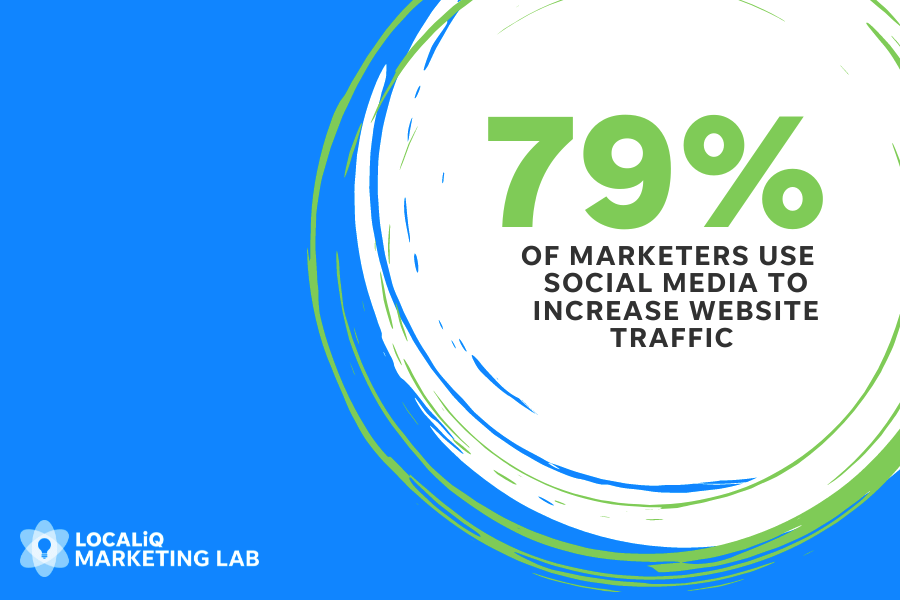
Improves ranking: Social media is not a declared ranking factor by Google, but there is no doubt that social signals have a positive impact on your organic rankings.
Enhances your appearance in search results: Google shows social media profiles on its results pages, so when someone searches your business name on Google, you can dominate that first page!
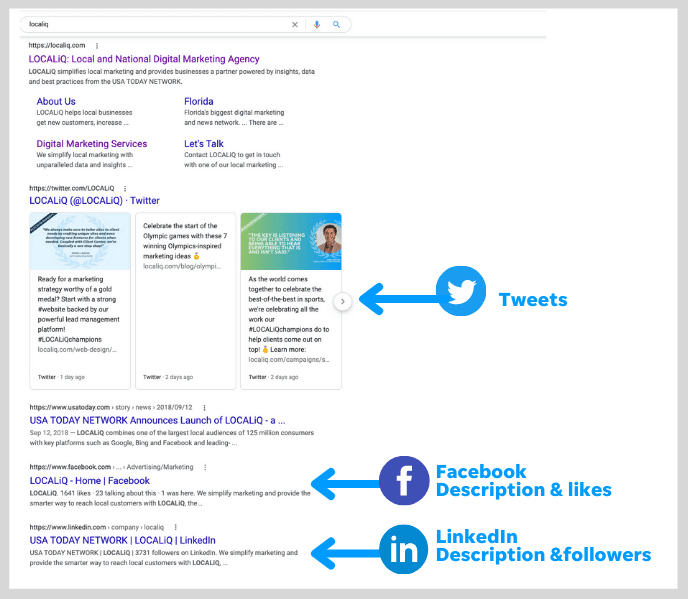
6. Social media marketing lands you more customers
If you’re reaping the benefits we’ve already covered—being able to connect with your audience anywhere, humanize your brand, amplify your reach, and strengthen your online presence—then you will almost undoubtedly land more customers from your social media marketing.
Even better? Consumers discover, purchase from, and review businesses on social media without ever visiting a website, so it’s a crucial sales tool! In fact, 60% of marketers see improved sales as a result of social media marketing.
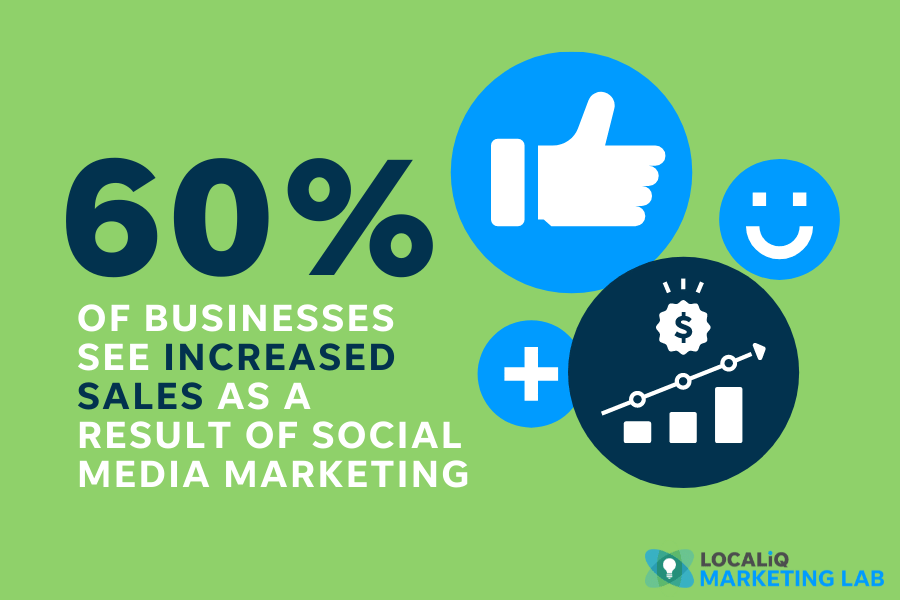
Lesson recap
Social media marketing helps your business to:
- Connect with your audience anytime, anywhere.
- Humanize your business.
- Amplify your reach.
- Improve your online presence.
- Land more customers.
If you’re eager to start social media marketing for your local business so you can enjoy these benefits, then read on! In the next part of the course, we’re going to guide you through getting started.
How to get started with your local social media marketing plan
While you may be eager to start seeing the many benefits of social media marketing, we don’t recommend hopping on the platforms and throwing up quick profiles. Carefully building out a solid foundation is important for long-term success.
The four most important steps for getting started are as follows:

1. Define your target audience on social media
The success of all your marketing hinges upon how well you know your target audience—not just their age and where they live, but how they live: their lifestyle, pain points, desires, fears, interests, core values, hobbies, and habits.
Make sure you have a firm grasp on those above details, and then ask yourself the following questions:
- Which groups in my target audience use social media?
- What platforms do they use?
- When in the day and week do they sign on?
- From what device?
- What do they see on their feeds?
- What do they search for and explore?
- What do they post?
- Who else do they follow?
- How much time do they spend on it?
- What topics and content formats do they engage with?
Answering these questions will help you to identify what to share, when to share, and on which platform, so you can increase engagement, create emotional connections with your audience, and build a loyal following.

2. Identify your broader social media audience
One of the unique things about social media marketing is that your ideal buyers make up a significant portion of—but not all of—your target audience. Social media platforms are giant communities, so your audience will also include:
- Non-competing businesses with similar audiences.
- Businesses and individuals in your local community.
- Fellow business owners or industry professionals around the world.
- Influencers in your geographic or virtual niche.
Each of these groups will engage with and share your content (and vice versa), so keep them in mind when posting and engaging on social media.
3. Choose your platforms
While each platform offers a unique set of benefits, engaging your audience across all of them won’t necessarily drive results for your local business. It depends on a number of factors:
- Your audience: It’s essential to know their preferred platforms.
- Your marketing goals: Looking to drive traffic? Facebook and LinkedIn are great for that. Focused on brand building? Instagram is your best friend.
- Your time: Social media is a real-time marketing channel, so you need to be active if you want to see results. How much time can you build into your schedule each week?
- Your existing content: If you have a lot of videos, you might want to use TikTok. If you have mainly blog posts and thought leadership pieces, stick to Facebook, LinkedIn, and Twitter
Social media marketing is free, but it does take time and effort. Concentrated and frequent attention on one or two platforms is better than sporadic efforts on all—so choose your platforms wisely!
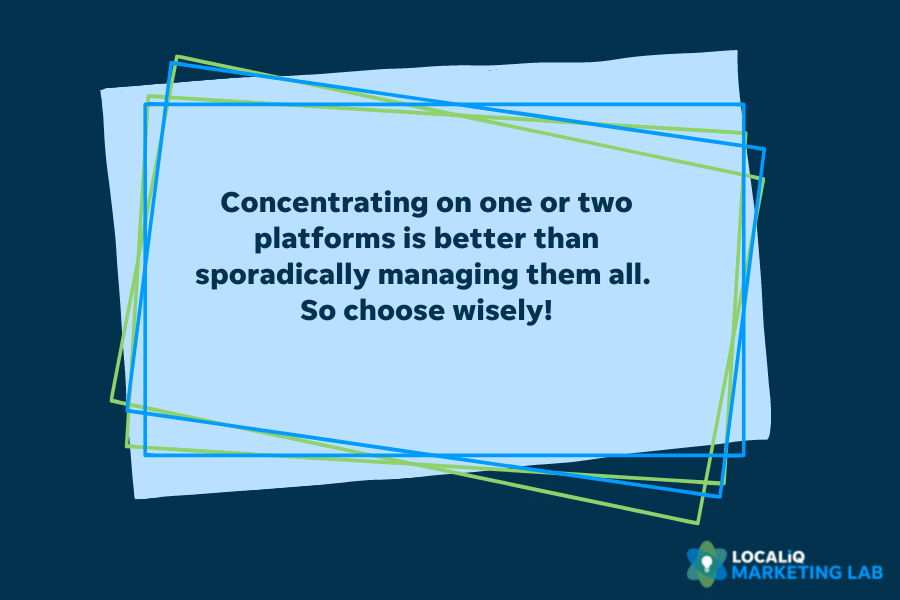
4. Set up your profiles
To be successful with your social media marketing, complete profiles are a must! The more information you have readily available to visitors, the more likely they are to click through to your website, contact you, explore more of your content, and/or choose to follow you.
A complete profile also ensures your business shows up in results for any applicable searches (including local searches!). So fill out every possible section, keep the information updated, and be on the lookout for new attributes and features.
Lesson recap
To get started with your local social media marketing, follow these four steps:
- Define your target audience
- Identify your broader audience
- Choose your platforms
- Set up your profiles
Profile setup looks different for every platform, so we’re going to guide you through profile setup in the next lesson. See you there!
Social media marketing for local businesses: profile setup
The bad news is, every platform is different. The good news is, we’ve got the checklist for a complete profile on each one. Let’s start with the most popular platform: Facebook.
Note: As these platforms frequently change, you can always double-check your images with this regularly updated social media image cheat sheet.
Facebook business page
Facebook doubles as both a social media platform and a massive business directory, so treat your Facebook business page as a local listing with a personal touch.
- Page name
- Profile photo: 170 x 170 px
- Cover photo: 820 x 426 px
- Description: 155 characters
- Categories: up to three
- Contact info: phone, website, email
- Location/hours: for physical stores
- Call to action button to go below cover photo
- Price range and any other industry-specific details

Instagram business profile
First off, head to your settings and make sure your Instagram account is set to “Business” so you can view analytics and get access to other marketing features.
Instagram bios are more of an art. There are only four fields and 150 characters, so make the most of it!
- Name
- Handle (@username)
- Profile photo:180 x 180px
- Description: 150 characters
- Link

LinkedIn company page
Similar to Facebook, LinkedIn company pages give you lots of fields and characters to provide information about your business.
- Name
- URL
- Tagline
- Logo: 300 x 300px
- Cover photo: 1128 x 191px
- Button: Add a custom button
- Description: 2000 characters
- Industry
- Company size
- Company type
- Phone number
- Address
- Year founded
- Specialties (up to 20)
- Hashtags (up to 3)
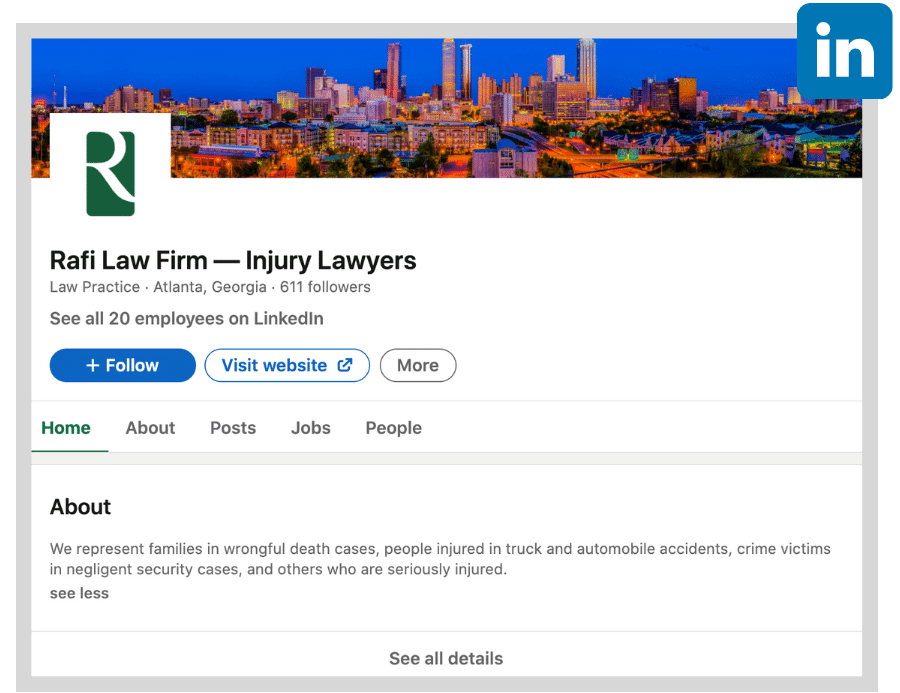
Twitter business profile
Like Instagram, Twitter profiles allow only a few characters. But like Facebook, you have a profile photo and a cover photo.
- Name
- Handle (@username)
- Bio: 160 characters
- Location
- URL
- Profile picture: 400 x 400px
- Header picture: 1500 x 500

TikTok business profile
TikTok profiles only give you 80 characters here, so be creative!
- Name
- Handle (@username)
- Bio: 80 characters
- Website
- Category
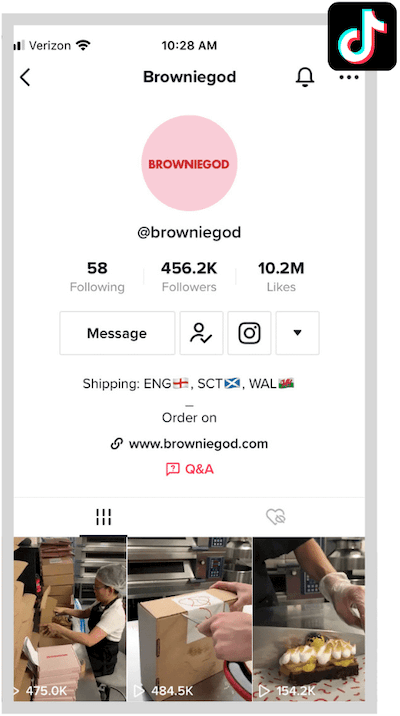
Snapchat business profile
Snapchat Business Accounts only have five fields. As of May 2021, you can also set your account to “Public Profile” which allows users to subscribe to your business.
For more detailed steps, check out how to set up a Snapchat business account here.
- Name
- Category
- Location
- Description
- Website
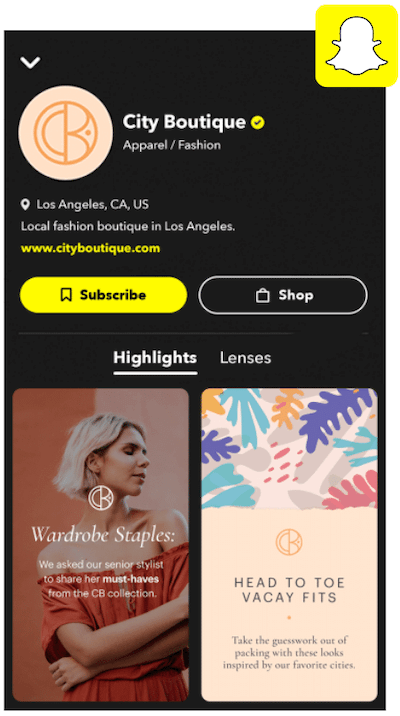
For all business profiles on social media:
- Choose a name/handle as close as possible to your business name.
- Fill out every section in a way that represents your brand and informs your audience.
- Make sure you have your logo uploaded (in most cases, as your profile picture) for brand awareness and recognition.
Alright! You’ve got your audience identified and you’re all set up. Time to start posting, right? Not so fast. In the next lesson of this course, we’re going to go over some important tips and best practices to help you maintain a positive reputation and get real results.
Local social media marketing tips and best practices
Social media is a versatile marketing channel you can use to express your brand personality, establish your expertise, connect on a deeper level with your audience, and ultimately hit your local marketing goals.
This will look different for every business and platform, but there are some universal tips and best practices to follow that will help you to reach those goals with the proper etiquette.
1. Engage with your followers
Social media platforms are conversational, which means you can’t just post and then expect users to follow you, continue following you, or become customers. You need to be an active participant.
It’s important to share useful information in your posts to demonstrate your expertise, but you should also engage with your followers more directly. Post polls, invite them to share their input on a topic, and ask for their personal recommendations (books or vacation spots, for example).
And engage back! Respond to their comments, follow them, like and share their posts. Post videos answering comments or go live and converse in real-time.

People want to be heard and appreciated. And it’s through genuine engagements like this that you’ll naturally attract followers, retain them, and turn them into customers and maybe even brand advocates.
2. Acknowledge and tag others
Social media platforms are communities, and your business is certainly not the only one that can provide valuable insights to your audience.
A portion of your social media posts should be curated content from niche influencers, reputable data sources, and fellow experts. This positions you as a contributor to the greater community—not just a user of each platform—and alleviates the pressure to always be creating new content.
Also, be sure to tag individuals in your posts. For example, tag happy customers on Facebook and Instagram; and if you’re sharing an article on Twitter or LinkedIn, tag both the writer’s company and their personal account (if they provide it in the article). This extra step goes a long way.
3. Publish a mix of content
Your main focus with social media marketing should not be on selling your products and service, but rather on serving your audience with useful and interesting material—which will in turn naturally promote your brand.
This means publishing content with an appropriate mix of purposes. The best rule of thumb for this is the 70-20-10 rule. It says that your posts should be:
- 70% informational: Altruistically benefit your followers with education, advice, updates, news, and insights.
- 30% emotional: Connect with your followers through expressions of company culture, core values, and fun/funny/inspirational content.
- 10% promotional: Directly promote your business, products, or services.
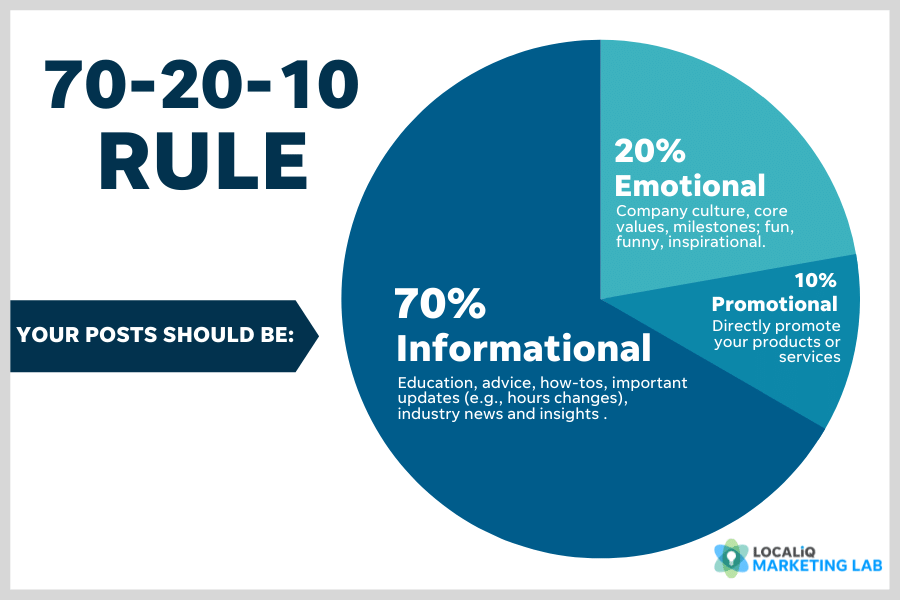
This balance makes your business visible, memorable, credible, and likable. When the time comes that someone in your audience needs your product or service, yours is the first business that comes to mind!
Of course, you can (and should) express your brand, culture, values, and even humor when posting informational content, but it’s okay for a portion of your posts to be purely entertaining or inspiring.
4. Stay consistent
Every platform is different, but the tone of voice and core messages you deliver across every social network should be consistent. Brand consistency allows your target audience to more easily recognize, recall, and trust your brand.
It’s also important to be consistent in your frequency of activity and engagement. Avoid sporadic activity by scheduling your posts and scheduling time for real-time engagement. As long as your followers have some idea of what to expect, you’ll have a smaller risk of disappointing them.
5. Rely on analytics, not assumptions
Intuition and follower feedback can give you a general idea of what engages and interests your audience, but data will always be the source of truth you need to inform your local social media marketing strategy. Most social media platforms have analytics capabilities that provide impression, engagement, and share metrics as well as audience insights. With this data, you can:
- Make sure you’re always publishing the most relevant content.
- Identify top-performing posts to repurpose or reshare down the line.
- Test and discover new content types with confidence.
- Establish a baseline and set quantifiable goals.
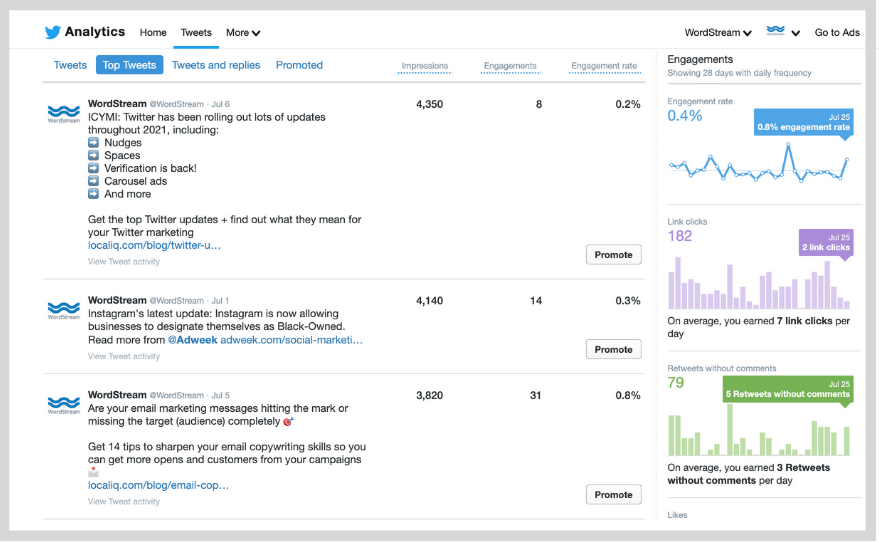
You should always be checking and improving your social media engagement, so analytics are a must!
6. Monitor other accounts
As with any marketing strategy, it’s important to pay attention to what other brands are doing on social media. This means following or monitoring accounts that belong to:
- Your competitors: What are some things they do well that you could adapt to your business? What are they lacking such that you could fill a gap?
- Industry authorities: Stay up to date on news and source relevant content you can share.
- Non-competing businesses with similar audiences: What topics or content seem to be most popular? What is going on in other aspects of your followers’ lives that your social media marketing could speak to?
- Other brands you like or who share your values: This is a great way to get inspiration for visual and emotional marketing.
- Your customers/fans: Follow them back! Join groups. There is no such thing as knowing too much about your target audience. Plus this is a great way to stay on top of consumer trends.

Following these account types will help you to keep up with competitors, stay on top of industry and social media trends, and also gain inspiration and new ideas.
7. Use design and automation tools
As a local business owner, there’s a good chance you’re already wearing quite a few hats to keep everything running. Rather than trying to juggle all of your accounts manually, take advantage of social media marketing tools that can save you time.
- Automation tools like Hootsuite enable you to schedule posts for multiple platforms at once and view your analytics all in one place.
- Creative tools like Canva can help you to create appealing and branded visuals—a must-have for social media marketing.
- Curation tools like ShareIt can help you to find interesting content and industry influencers.
- Link shorteners like bit.ly can keep your posts clean.
It might cost you some time upfront to learn a new tool, but in the long run, it will help you get the best return on your investment and free up more time for you to focus on running your business.

And if you’re thinking that social media platforms are only for social media managers looking at three screens all day or influencers with massive followings, think again! They’re just as important for the local business owner who may engage more personally with a smaller following across platforms.
7. Don’t fuss—repurpose!
Coming up with and creating content in general can be a time-consuming challenge, let alone on social media where you publish most frequently. And this is why repurposing is your best friend in social media marketing. Here are some ways to repurpose your content for social media:
- Create posts that link to your blogs, success stories, and guides.
- Extract stats, short lists, or interesting excerpts from your long-form content and create a post out of them.
- Record yourself summarizing the key points of a post.
- Regularly republish posts linking to your evergreen blog content.
- Re-share past posts that have performed well.
- Resurface seasonal content
- Repurpose TikTok videos for Instagram Reels, and so on.
Not only is repurposing one of our top time-saving social media tips, but it will also help you to drive home important messaging and engage new followers without disengaging your existing ones.
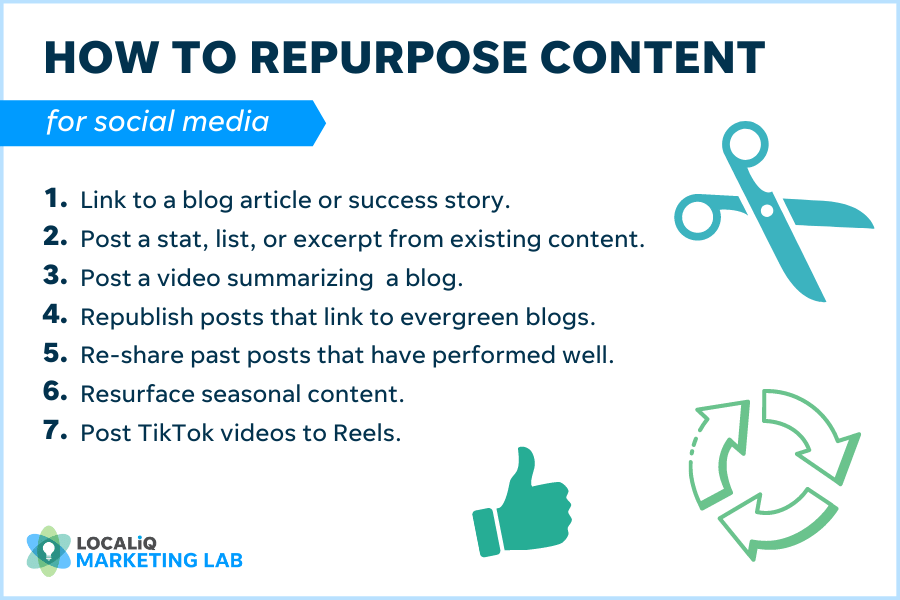
8. Add a mix of hashtags
On social media, you can search any topic prepended with the # sign and you will see all pages, posts, and profiles containing that hashtag across the entire platform. Also, simply tapping on a hashtag performs an automatic search for you. Topics range as far and wide as Google searches, but here are the main categories that help with marketing:
- Industry hashtags: #taxtips, #diyeventdecor, #telehealth, #ppcadvertising
- Custom hashtags: #yourbusinessname, #logosbyparamount, #wordstreamlive2018
- Popular/trendy hashtags: #throwbackthursday, #travelgram
- Lifestyle hashtags: #localbusinessowner, #workoutwednesday, #officeview
- Location-based hashtags: #austinphotographer, #bostonkarate, or #nycbrunch
It’s best to use a mix of hashtag types so you’re increasing your reach but to a relevant audience.
 For more help, head to our hashtag how-to (which also has 335 hashtags you can use!).
For more help, head to our hashtag how-to (which also has 335 hashtags you can use!).
9. Prioritize visuals and video
We always hear that Instagram is the most visual platform, but in our opinion, all social media platforms are visual. Eye-catching, clean, and uncluttered posts are the keys to standing out in your followers’ feeds and garnering engagement. Even on LinkedIn, posts with an image see a 2x higher conversion rate than posts without.
Here are some tips for giving your social media posts visual appeal:
- For posts that include links to your blog and website, make sure you have (good!) featured images uploaded for those pages so that you can just use the image that automatically populates.
- For posts without links, you could create a graphic with the information or get creative with emojis.
- Make sure your profile and cover photos are high-quality. Appearance influences brand perception.
- As for video, you can upload them directly to the platform or record live sessions on Instagram and Facebook.

10. Add social buttons to your website
Here is where your SEO strategy comes into play! With social sharing buttons, you can turn website visitors into followers and even promoters of your business.
The first way to do this is to add social icons to your site that link to your profiles. A good place for these icons is in your website footer, but you may also want to place them prominently on your contact us page or blog homepage.
![]()
The second way to do this is to add sharing buttons to your blog posts so readers can post it to their feed with the click (or tap) of a button.

11. Advertise on social media
While this course is focused on organic social media marketing strategies, it’s definitely worth mentioning paid advertising here. One of the key advantages of social media ads is the superior targeting, since users publicly share so much information about themselves in their profiles. And as mentioned earlier in this course, social advertising is relatively inexpensive compared to other marketing strategies.
So while your organic efforts are building your audience, brand, and relationships, you can have your paid efforts generating new leads and customers—the perfect pair!
To learn more about paid advertising, check out our Local PPC Course.
12. Be patient
The focus of your social media marketing should not be to gain followers. It should be to build an audience of individuals who will benefit from, engage with, and share your posts and offers. This way, your followers will get value out of your content while at the same time bringing you new followers and insights, which will ultimately help you drive your marketing goals.
But this doesn’t come overnight. It comes by consistently publishing quality content, engaging with followers, connecting with individuals, and expressing your brand voice and values over time.
So don’t give up if you’re not getting results right away! Slow growth means sustained growth.
Lesson recap
And that wraps up our social media marketing tips! Let’s do a quick recap:
- Engage with your followers.
- Acknowledge and tag others.
- Publish a mix of content.
- Stay consistent.
- Rely on analytics, not assumptions.
- Monitor other accounts
- Use design & automation tools..
- Don’t fuss—repurpose!
- Add a mix of hashtags.
- Prioritize visuals and video.
- Add social buttons to your website.
- Advertise on social media.
Now it’s time to move on to the fun stuff—posting ideas!
Social media post ideas for local businesses
So you’ve identified your target audience, picked your platforms, and set up your profiles. You’ve got the best practices nailed down and know the best ways to maximize your success. Now it’s time to get posting!
So…what to post. Well, we talked about the 70-20-10 rule earlier in this course, but even still, the sky’s the limit in terms of what falls into those three buckets (informational, emotional, and promotional). So we’ve come up with a master list of post ideas, grouped by the following categories:
- Self-promoting
- Company success
- Company culture
- Practical and tactical
- Educational
- Engaging
- Creative and entertaining
As you’re browsing, keep in mind that not every post is suitable for all platforms or businesses, and that these are far from black-and-white categories!
1. Promotional post ideas
These social media posts are self-serving and geared for users looking to buy. They refer directly to your products and services and typically contain some sort of call to action, such as to give you a call, click through to a product or landing page, or visit a physical location. Post types in this category include:
- Promotions: deals, discounts, promo codes, flash sales, limited-time offers.
- Products/services: current offerings, product/service launches, feature releases, product demos.
- Social proof: reviews, testimonials, success stories, case studies.
- Events: encouraging followers to visit your table at trade shows, farmers’ markets, and other local events.
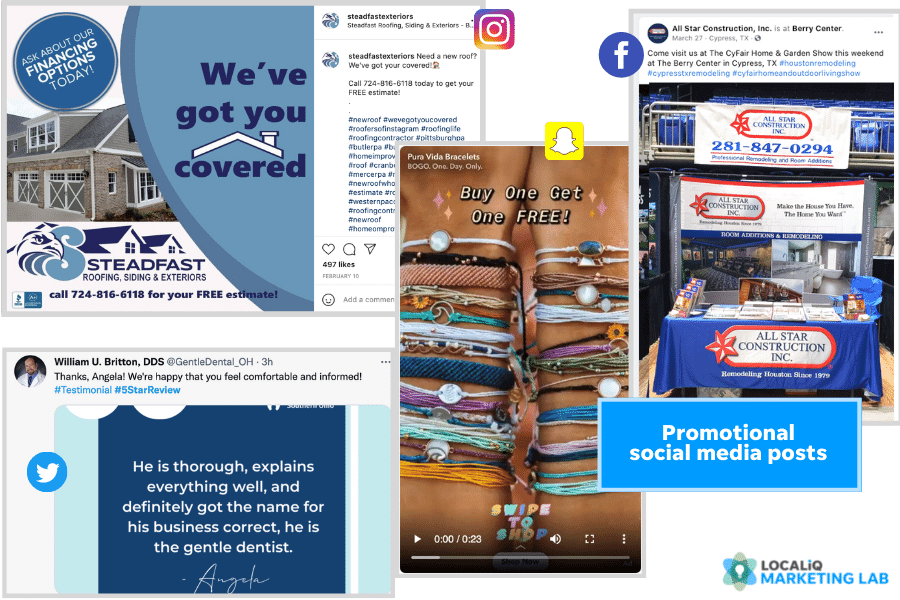
2. Company success post ideas
Company success posts are also self-serving and directly related to your products and services, but less about pushing sales. Instead, they celebrate your successes and invite your followers to be a part of it. These include posts about and/or that contain links to:
- Achievements: Milestones like reaching your nth customer, awards.
- Gallery: Images of your completed projects, before-and-after photos, or of you/your employees on the job.
- Customer spotlights: Feature customers with unique or inspiring histories or follow up with former customers to see where they are today.
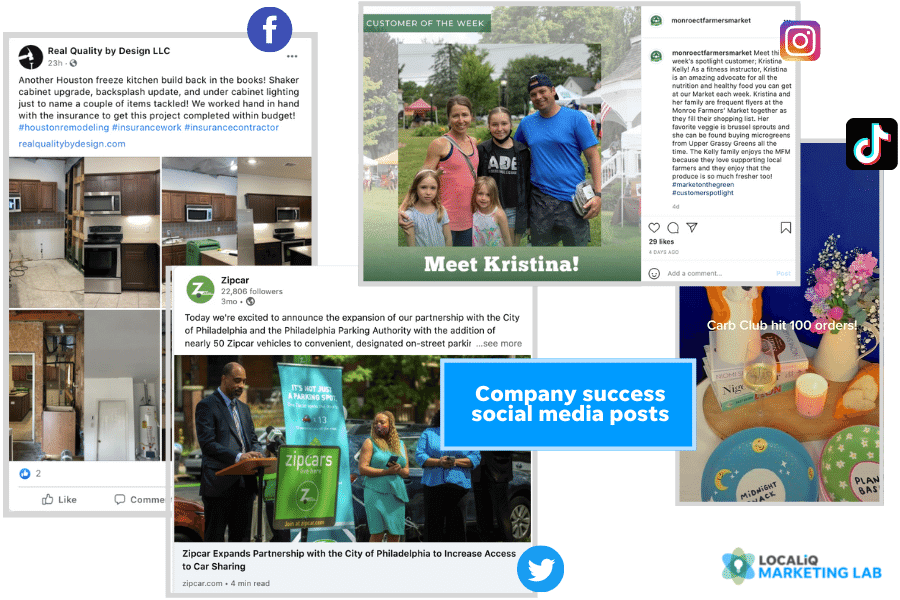
3. Company culture post ideas
These posts are not so much self-serving as company-centric, but are geared toward brand building and personal connection with your audience.
- Company history: Founding stories, blasts from the past, fun facts.
- Behind the scenes: Share experiences from office or company-only events, day-to-day work, office pets, and more.
- Employee spotlights: Feature new hires, employee Q&As, award-winners, and anniversaries.
- Personal takes/experiences: Share thoughts related to news, industry topics, or your values.

4. Practical & tactical post ideas
These social media posts are characterized by actionable content that demonstrates your expertise in your niche. The goal here is to show your audience that your overarching goal is to help your audience solve their problems, not simply make a profit. This means They include posts about and/or that link to:
- Hour/location changes, job postings
- How-tos
- Tutorials
- Tips and strategies
- Ideas and templates
- Tool and resource lists
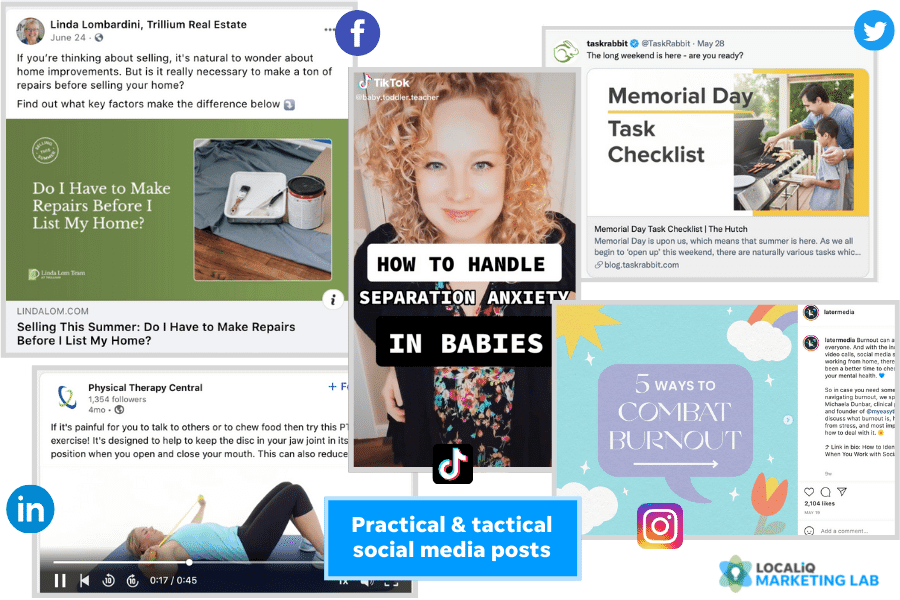
5. Educational post ideas
These posts are still practical, but don’t necessarily have to be actionable. They demonstrate your industry authority and awareness of current events and trends. The goal with educational content is to help your audience grow and make informed decisions, as well as build trust with your business. They include posts about and/or that link to:
- Industry stats
- Industry news and insights
- Thought leadership
- Best practices
- Personal or professional development tips
- Conference or event takeaways
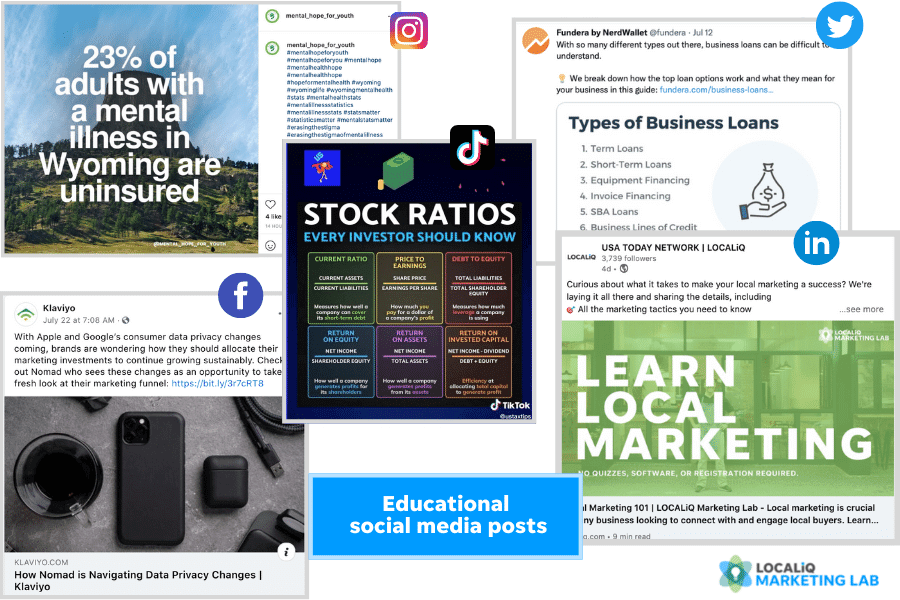
6. Engaging post ideas
Of course, all of your social media posts should be engaging, but these posts explicitly ask for and make it easy to engage—usually right within the post itself. They include:
- Contests/giveaways
- Questions, caption contests, fill in the blanks
- Polls/feedback/surveys
- Recommendation requests
- Discussions
- Event invites
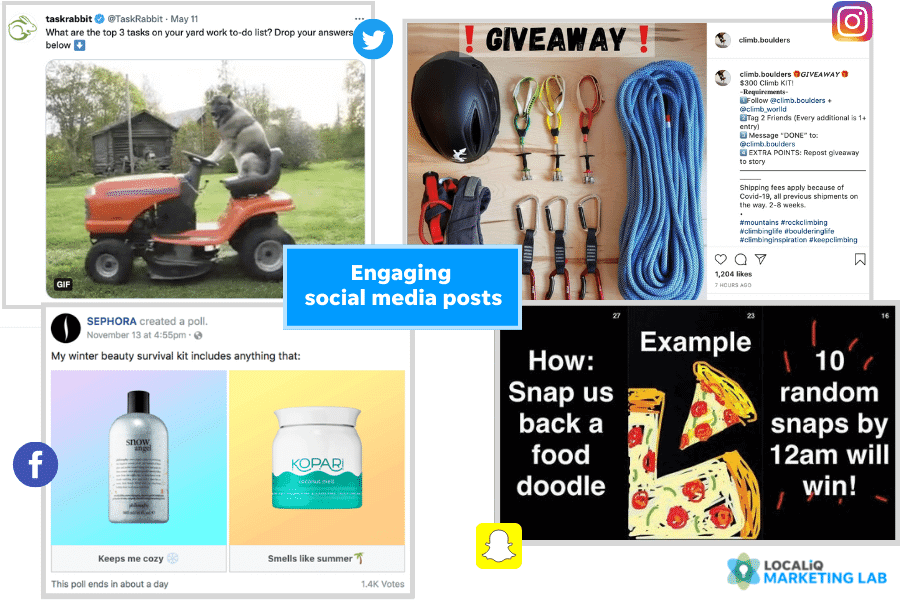
7. Creative & entertaining post ideas
As we mentioned earlier in this course, social media is great because it helps you to build a full 360 degree profile of your business. This includes the lighter side of your business. These types of posts help to express your brand’s personality and connect emotionally with your audience. They don’t necessarily have to be related to your business, but could be related to your values or representative of your own personality. They include posts with:
- Stories
- Quotes
- Captions
- Experiences
- Memes and GIFs
- National day posts
- Memes
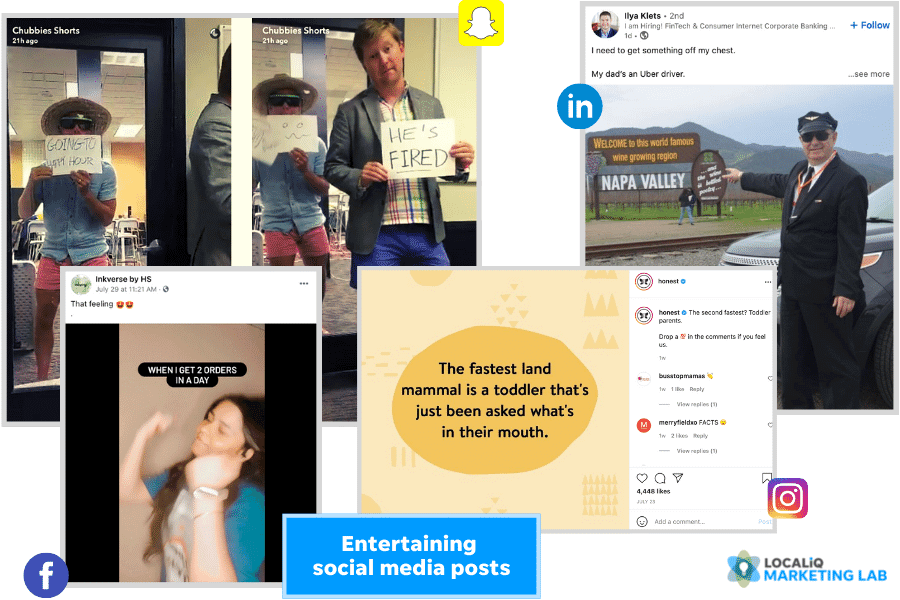
Now you have a cheat sheet of social media ideas. Bookmark it!
What to post on social media for each channel
Whether shoppers are browsing social media in discovery mode or searching specifically for a business like yours, they have a short attention span. You have a limited amount of time and space to capture their attention. Plus, posting too much can reduce engagement! So that’s why we’re breaking down what and how often to post on each platform.
Facebook marketing for local businesses
As we talked about earlier in the course, Facebook has the largest audience and is great for building relationships, keeping customers updated, and connecting with your local niche.
Types of Facebook posts
- Regular posts
- Pinned posts
- Stories
- Live streams
- Watch parties
- Job openings
What to post on Facebook
Facebook is the most versatile in terms of what information to share, but there is a particular focus on community and discussion. It’s personal and conversational, so feel free to express your brand’s values and appeal to the emotions–just be sure to keep it relevant to your business and avoid controversial topics. This is also the place to post timely information like hours changes or updates on events.
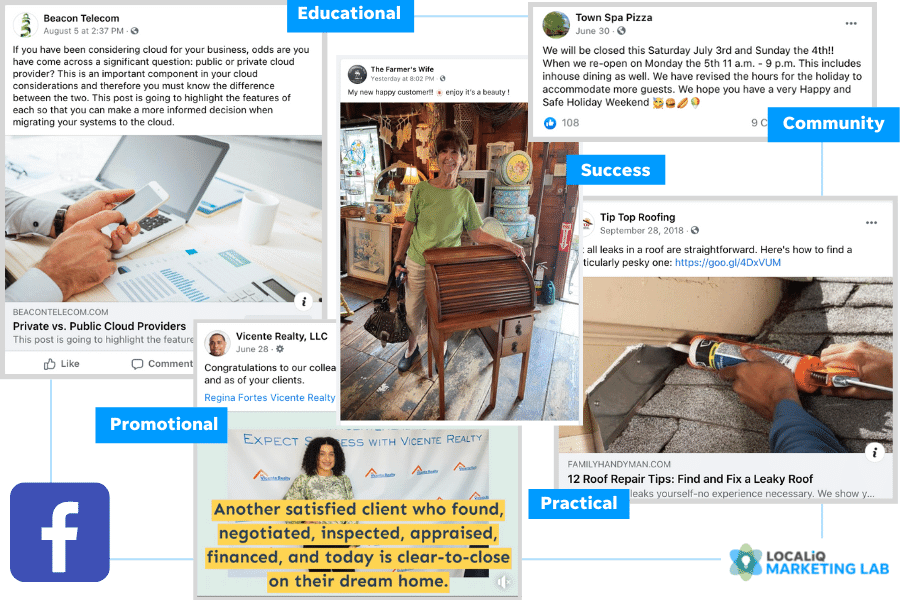
How often to post on Facebook
Hootsuite recommends at least one post a day but no more than two.
Facebook marketing tips
- Enable Facebook Messenger to chat live with potential and current customers.
- Be proactive in getting customer reviews on your business page.
- Follow these strategies to promote your Facebook page for free.
Instagram marketing for local businesses
Instagram has a variety of post types that help to support different marketing goals, and keep in mind that 70% of shoppers look to Instagram for their next purchase.
Types of Instagram posts
- Feed posts: photo or video, go in your permanent gallery.
- Stories: self-erase every 24 hours, only for followers.
- Highlights: Stories you feature in your permanent gallery.
- Reels: Short videos, have a tab in your permanent gallery.
- Live streams: Live video sessions that can be saved.
What to post on Instagram
Instagram is geared for brand building and aesthetics. It’s a great place to highlight people, products, and your latest work. Images and videos should be high-quality, but Stories are meant to be unpolished and scrappy. You have captions to work with here, but Instagram is fast-paced and your visuals should do the communicating.

For more specific ideas, check out our post: What to Post on Instagram: 9 Creative (& Easy!) Ideas
How often to post on Instagram
For your regular feed, this depends on your industry. It’s much easier for an interior designer or home remodeler to produce compelling visual content than for a lawyer or appliance repairman. Hootsuite recommends 2-3 times per week, but no more than once per day. Also, make sure you know the best time to post on Instagram for your audience.
Instagram marketing tips
- While you can add up to 30 hashtags in your caption, stick with just a few. Too many can look spammy.
- You can’t add links to captions, but if you want to promote a page, make it your bio link and in your caption, tell users to head there.
- Use your feed for high-quality and evergreen posts, Stories for more of your spontaneous and fun content.
For more Instagram marketing tips, check out these posts:
- 6 Tips to Make Instagram Marketing Powerful for Your Business
- 17 Instagram Growth Hacks to Get More Followers Fast
- 8 Best Instagram Marketing Tips for Businesses in 2021
LinkedIn marketing for local businesses
While LinkedIn is for professional content, that does not mean boring content! LinkedIn is a community of people who are passionate about learning and growing.
Types of LinkedIn posts
- Posts (images/vids)
- Native articles (written directly in the platform)
What to post on LinkedIn
LinkedIn is community- and discussion-oriented like Facebook, but with a professional lens. It’s where members go to educate themselves, grow in both character and career, and keep up with their industry. Your content should facilitate that, but you don’t have to be super formal or dry. Aim for thought-provoking content, be slightly less casual than Facebook, and feel free to promote your company culture.

How often to post on LinkedIn
According to LinkedIn, companies that post weekly on LinkedIn see a 2x lift in engagement on their posts. Social Media Today recommends at least 2-3 times a week but no more than once a day
LinkedIn marketing tips
- Encourage your employees to share company content and announcements on their feeds. Content shared by employees receives 8X more engagement than content shared by brand channels!
- Build your personal brand on LinkedIn as well. Your professional reputation and your company’s reputation complement one another.
- Focus on sharing thought leadership content—like strategies you use, philosophies you live by, your unique perspective on a topic, etc.
Twitter marketing for local businesses
Twitter is a great channel to: connect with your virtual niche, share relevant news, and broaden your perspectives.
Types of Twitter posts
- Regular tweets
- Retweets
- Cards (Website Video, Tweet to Unlock, Media Poll, and Conversational Cards)
What to post on Twitter
People go on Twitter to keep up with news, express their opinions, and explore their niche. So there’s a discussion aspect but at a fast pace, so stick to quick facts and short (even witty) statements. Get creative with your 320 characters! You can add links to long-form content, but Twitter users are in quick scroll mode (and less likely to click on your links), so make sure your captions add value independent of the content they link to.

How often to post on Twitter
With thousands of tweets happening every second, it’s easy to get lost in the shuffle. Hootsuite recommends tweeting no less than 1-2 times per day and no more than 5 times per day
Twitter marketing tips
- Twitter is continuous and fast so don’t spend too much time on your posts.
- Use Tweetdeck! This free tool will help you create custom real-time views and stay on top of Twitter updates.
- Twitter is the home of the hashtag, so use ‘em!
TikToK marketing for local businesses
TikTok is a great channel to express your brand personality, keep up with trends, and make memorable impressions.
What to post on TikTok
TikTok increased the max video time from one minute to three minutes, but short videos between 9 and 15 seconds tend to perform best. People visit TikTok to have fun, see the latest trends, and connect with celebrities, so make sure to keep your videos light, fun, and on-trend.
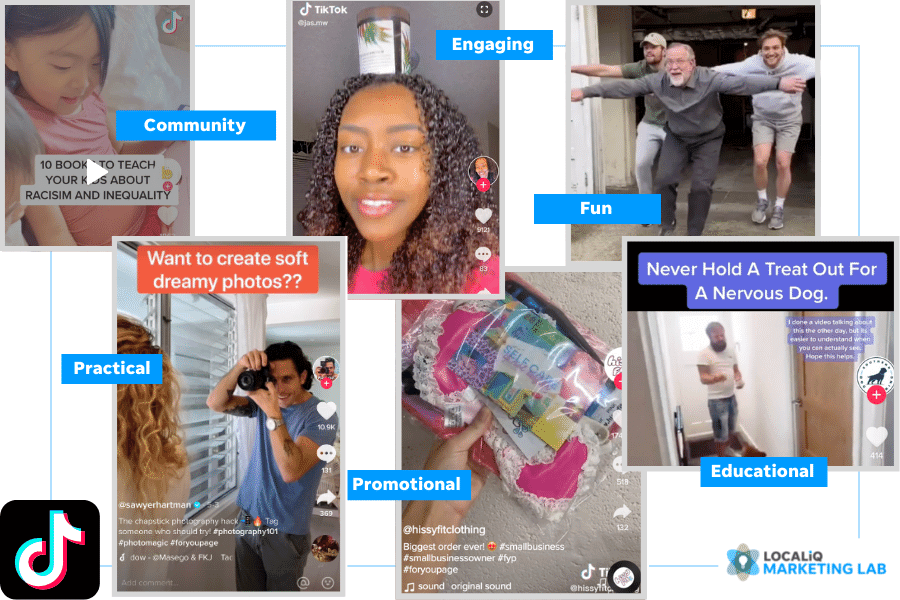
How often to post on TikTok
If you’re going to invest in TikTok as part of your local social media strategy, it may require a bit of a commitment—experts suggest posting at least 1-3 times per day (best times to post on TikTok here). But the most important thing with TikTok is to remain consistent to build followers and use trending sounds as the foundation for your videos.
TikTok marketing tips
- The best way to show up in a user’s feed is to get shown on the For You Page. And the best way to do that is to hop on trends on TikTok—including challenges and using trending sounds or music.
- Hashtags are an important way to get found on TikTok, so research the best hashtags to use in both your area, niche, and what’s trending.
- The best TikTok videos are silly, unique, and creative—so get those creative juices flowing!
Snapchat marketing for local businesses
Snapchat is a great channel to reach nearby audiences, show your creativity, and demonstrate transparency.
What to post on Snapchat
For businesses, the best way to use Snapchat is through Snapchat advertising, but if you build an audience on the platform, you can post fun images and short videos. Remember that a Snapchat Story is meant to capture attention quickly—so keep your videos short and sweet. And remember your audience as you’re posting—they opt for fun, bright, and eye-catching visuals.
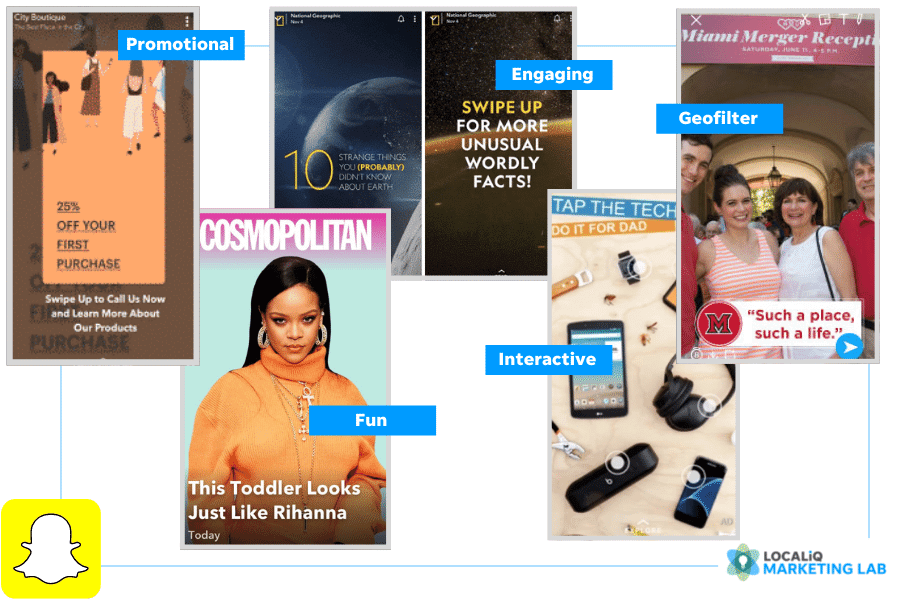
Types of Snapchat posts
- Snaps
- Stories
- Highlights
How often to post on Snapchat
You don’t have to post too frequently on Snapchat. Experts recommend 4-7 times per week, but it all depends on your audience size and your goals.
Snapchat marketing tips
- Tag your location in your Snaps or use geofilters so you can increase your chances of showing up in an aggregated story highlight on Snapchat.
- See if your business is on the Snap Map and manage your listing.
- Keep your posts fun and think outside the box!
How to optimize social media for local marketing
If you’ve followed the steps and tips throughout this course, you’ll be well on your way to achieving local marketing success through social media. But let’s finish off with some additional ways to optimize your social media accounts for local marketing.
1. Treat your profiles like listings
Social media platforms can and do serve as local listing directories, so make sure to supply all of your contact information in your profiles. This will make it easy for nearby users to both discover and get in touch with you.
This is especially important for Facebook business pages, which offer the most comprehensive view of your business, comparable to your website or Google My Business profile. It is also a powerful local business directory. In fact 66% of Facebook users visit a local business page at least once a week.
2. Use local keywords
Even though there are address fields in your profiles, include your location in your bio and description.
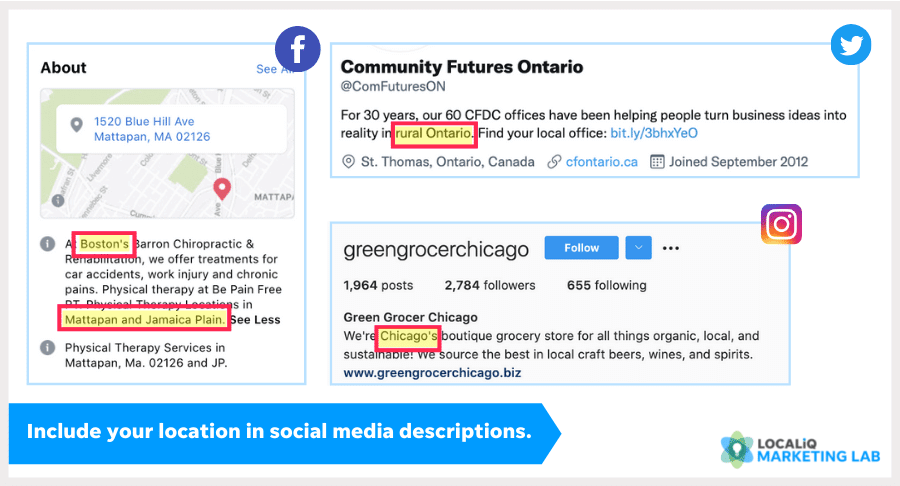
Also, add locations to your posts that have to do with local topics, as it will send relevant local signals to Facebook and Google.
3. Add your business to Facebook Places
Facebook is quite the local search engine these days. Search for any service and you’ll see Places results just like on Google, and Pages results for nearby businesses.
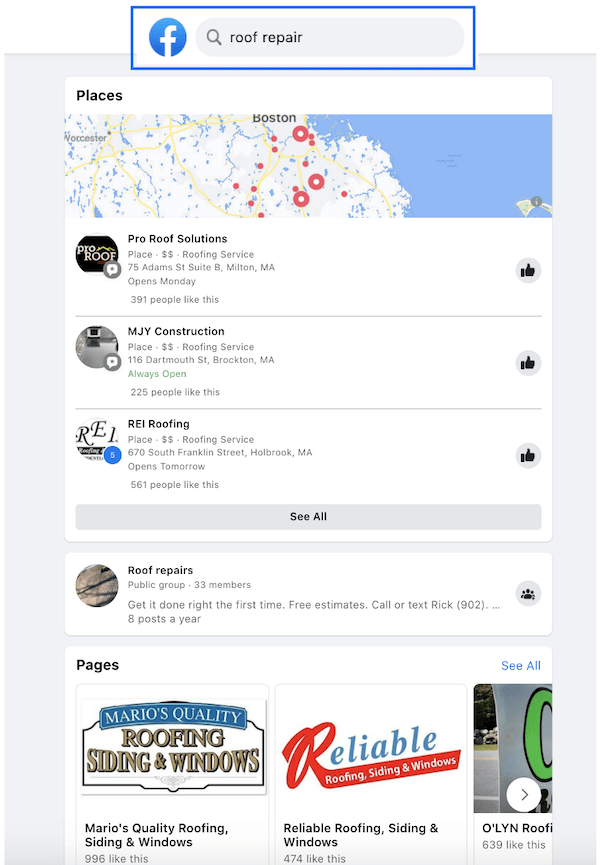
To show up in local results on Facebook, set your business to “local business or place.”
This way,
- You can add hours and other listing information to your business page.
- Customers to check in at your business (to endorse it and expand your visibility).
- Users can see when their friends are at your business (via Nearby Places).
Just like with local SEO, be sure to optimize your page to rank as high as possible in results (having a complete profile, gathering reviews, and being active on the platform).
4. Use Facebook events
When you host events in and for the community, create Facebook events for them. Not only does this encourage attendance and give you one place to share information, post updates, and track RSVPs, but it has additional local marketing benefits.
If your event is open, it will show up in the Events tab of search results. Facebook will also suggest the event to users in the area, and let users know about events their nearby friends are attending.
5. Encourage user-generated content
Encourage your customers to post pictures of themselves at your business and using your products/services, and make it easy for them to tag your handle or check in at your location. This way, they’re promoting your business to their networks, which almost certainly includes individuals in their geographic vicinity.
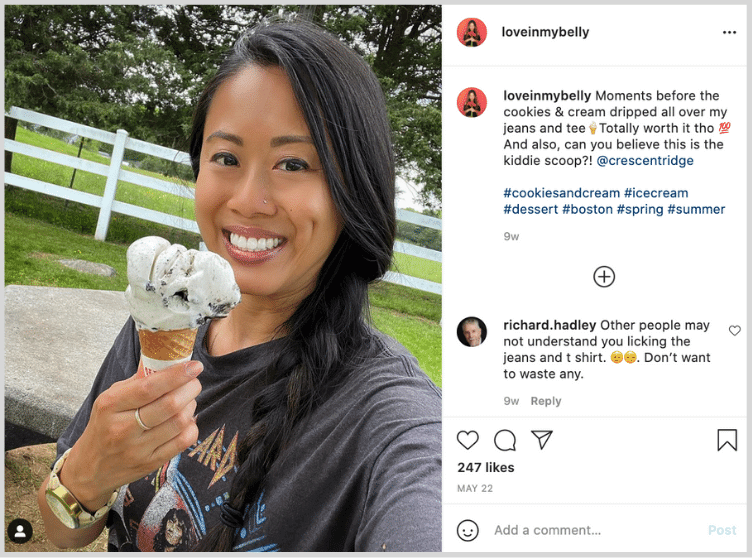
This also means tagging your customers in your own posts.
6. Share location-specific media
Social media is the perfect place to strengthen your ties with your local community. Here are some of the many ways you can do this:
- Use a familiar landscape, cityscape, or mountain range as your cover photo.
- Create posts with images of landmarks or town favorites in your posts.
- Use language and terminology specific to your town or area in your captions.
- Follow and engage with neighboring business accounts or influential members of your community.
- Share your experiences when you promote, attend, and sponsor community events.
- Repost or share curated local content, including news, events, interesting stories.
7. Include location-based hashtags
As we mentioned earlier in the course, hashtags can increase your visibility across social media. But location-based hashtags have the special advantage of increasing your visibility in your local community. Here are some examples of location-based hashtags you can adapt to your business:
- #bostonbrunch
- #denvercakeshops
- #stoughtonkarate
- #chicagohairstylist
- #backbayrealestate

8. Join local groups on LinkedIn and Facebook
You’ll do this with your personal accounts. Local groups are powerful networking tools that also enable you to learn from other businesses, share your expertise, and get audience insights. For example, dog trainers or daycares might join a “Dog Owners of [Town/City]” Group. Just be sure to only contribute useful information and advice. In other words, never promote your business directly. Let your expertise speak for your business, which members can discover when they go to your personal profile.
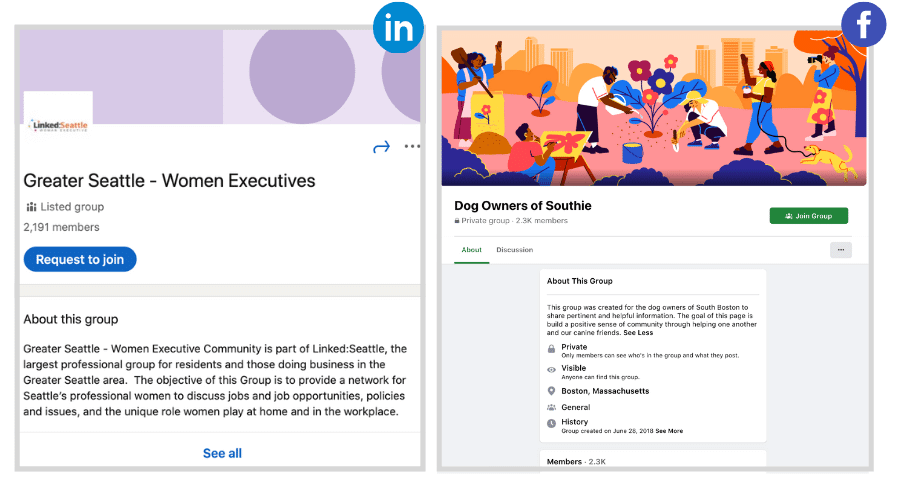
9. Create your own Snapchat geofilter
A geofilter is an overlay of text, borders, and/or graphics that users can apply to their snaps when in the specified location.
What’s great about geofilters is you can create your own with branded elements that you, your customers, and employers can use when at your business.
You could even create friendly competitions and contests for your customers to send you snaps of them using your product or service with the filter applied.
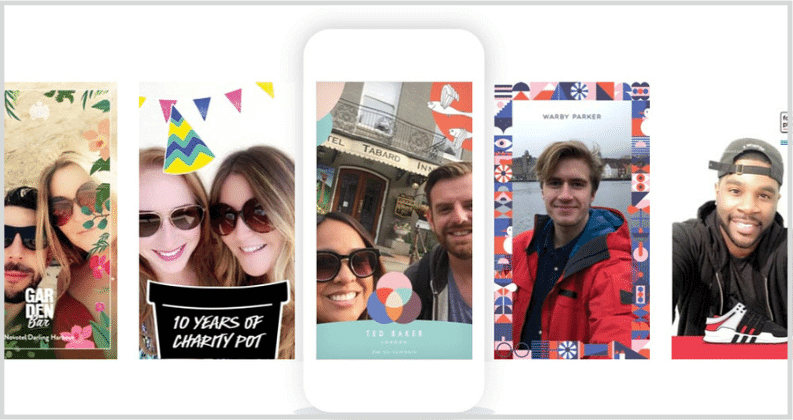
Local social media marketing wrap-up
With its many different platforms and massive networks, social media can be overwhelming, but with the lessons in this course, you can turn it into a low-cost, easy, and highly effective local marketing tool for your business. And remember:
- You don’t have to be great to start, but you have to start to be great
Don’t be intimidated! Start simple, and with practice and trial and error, you’ll get the hang of it in no time. - There aren’t any rules.
Every business is unique, and you know your audience best. So use these tips and ideas as guidelines to give you a jump-off point, and let your data guide you the rest of the way. - Have fun with it!
Social media is a playground for creativity, expression, and engagement. Have fun while growing your local business!
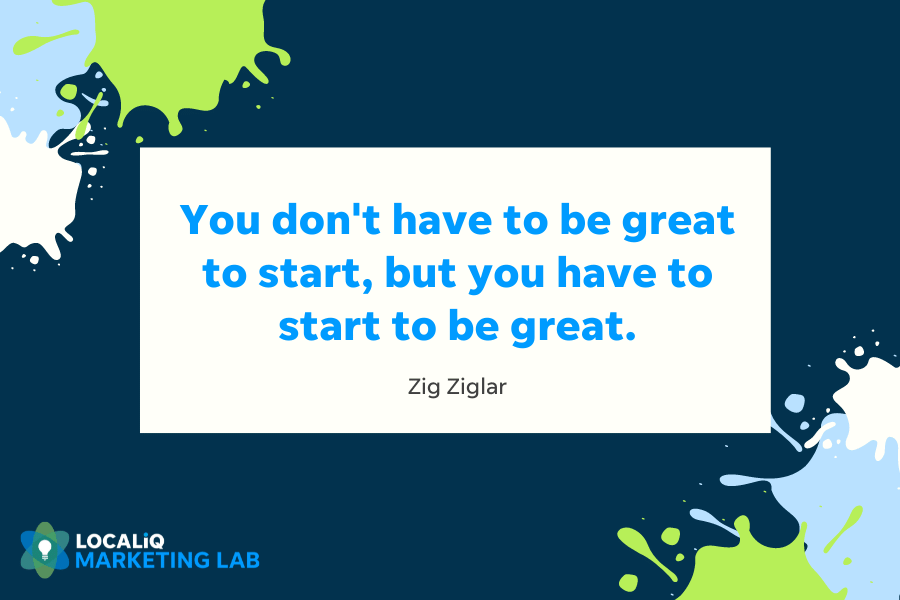
Congratulations, social media marketing expert!
You did it! Now you know how social media marketing works, what to post on each channel, and how to use it to grow your local business.
Want to keep learning? Check out our other Marketing Lab Courses: